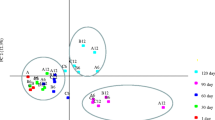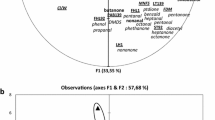Abstract
Cheese ripening involves lactose metabolism, lipolysis and proteolysis, which are affected by many factors. The aim of this study was to assess changes due to ripening (90 days) of goat milk cheese through bacteriological and physicochemical analysis in order to verify if, at the end of ripening period, this cheese could be considered “lactose-free”. Three batches of the goat milk cheese were manufactured and ripened at 10 °C and 80% relative humidity for 90 days. Titratable acidity increased by about 59 °D due to carbohydrate degradation and organic acid production. However, pH (5.31–5.25) remained constant. Lactococcus was the dominant cheese microbiota, acting in the fermentation of lactose (1.17–0.06 mg/g) and lactic acid production (5.49–s10.01 mg/g). Thus, ripening time was decisive for bacteriological and physicochemical goat milk cheese characteristics.



Similar content being viewed by others
References
AOAC. Official methods of analysis of AOAC. 18th edition. Association of Official Analytical Chemists, Gaithersburg (2012)
APHA. In: Compendium of Methods for the Microbiological Examination of Foods. Frances PD, Keith I (eds). Washington, DC (2001)
Atasoy AF, Türkoǧlu H. Lipolysis in Urfa cheese produced from raw and pasteurized goats’ and cows’ milk with mesophilic or thermophilic cultures during ripening. Food Chem. 115: 71-78 (2009)
Baranyi J, Roberts TA. A dynamic approach to predicting bacterial growth in food. Int. J. Food Microbiol. 23: 277-294 (1994)
Bezerra TKA, Arcanjo NMO, Garcia EFG, Gomes AMP, Queiroga RCRE, Souza EL, Madruga MS. Effect of supplementation with probiotic lactic acid bacteria, separately or combined, on acid and sugar production in goat “coalho” cheese. LWT-Food Sci. Technol. 75: 710-718 (2017)
Boutoial K, García V, Rovira S, Ferrandini E, Abdelkhalek O, López MB. Effect of feeding goats with distilled and non-distilled thyme leaves (Thymus zygis subsp. gracilis) on milk and cheese properties. J. Dairy Res. 80, 448-456 (2013)
Brazil. Ministry of Agriculture. Normative Instruction No. 37 of October 31, 2000. Technical regulation of production, identity and quality of goat’s milk. Official Journal of the Union, Brasilia, p. 23, Section 1 (2000) Available from: http://extranet.agricultura.gov.br/sislegis-consulta/consultarLegislacao.do?operacao=visualizar&id=2193
BRAZIL. Ministry of Health - ANVISA. Resolution of the Collegiate Board - RDC No. 135, of February 8, 2017. Amends Ordinance SVS / MS No. 29 of January 13, 1998, which approves the technical regulation for special purpose foods, to provide for lactose-restricted diets. Official Gazette, Brasília, DF, No. 29 (2017). Available from: http://portal.anvisa.gov.br/documents/10181/2955920/RDC_135_2017_.pdf/ac21ecc5-b439-4872-8a11-01cbef2d3d51
Commission Directive 2006/141/EC of 22 December. Official Journal of the European Union, 1-31. 20/12/2006. L 401 (2006)
Costa M, Conte-Junior C. Chromatographic methods for the determination of carbohydrates and organic acids in foods of animal origin. Rev. Food Sci. Food Saf. 14:586-600 (2015)
Costa M, Conte-Junior C. Analytical Applications of Evaporative Light Scattering Detection for Determination of Carbohydrates and Organic Acids in Food. In book: Reference Module in Food Science. (2017)
Costa M, Frasao B, Lima BC, Leal B, Conte-Junior C. Simultaneous analysis of carbohydrates and organic acids by HPLC-DAD-RI for monitoring goat’s milk yogurts fermentation. Talanta. 152: 162-170 (2016)
Costa M, Silva HLA, Balthazar CF, Franco RM, Cortez MAS. Economic performance and sensory analysis of probiotic “Minas Frescal” cheese produced using bovine and caprine milk. Enciclopédia Bioesfera 9: 2306-2314 (2013)
Delgado FJ, González-Crespo J, Cava R, Ramírez R. Free fatty acids and oxidative changes of a raw goat milk cheese through maturation. J. Food Sci. 76: C669-C673 (2011)
EFSA Panel on Dietetic Products, Nutrition and Allergies (NDA). Scientific opinion on lactose thresholds in lactose intolerance and galactosaemia. EFSA J. 8(9): 1777 (2010) Available online: www.efsa.europa.eu/efsajournal.
FAO. FAOSTAT. Food and Agriculture Organization of the United Nations, Rome, Italy, (2016) http://faostat.fao.org/site/339/default.aspx.
FIL-IDF. Milk and milk products. Preparation of test samples and dilutions for microbiological examination. Standard 122B. Int. Dairy F., Brussels, Belgium (1992)
García V, Rovira S, Boutoial K, Ferrandini E, López MB. Physicochemical, microbiological, textural and sensory changes during the ripening of pasteurized goat milk cheese made with plant coagulant (Cynara scolymus). Int. J. Dairy Technol. 69: 96-102 (2016)
Guerzoni ME, Vannini L, Lopez CC, Lanciotti R, Suzzi G, Gianotti A. Effect of high pressure homogenization on microbial and chemico-physical characteristics of goat cheeses. J. Dairy Sci. 82: 851-862 (1999)
Kondyli E, Pappa EC, Svarnas C. Ripening changes of the chemical composition, proteolysis, volatile fraction and organoleptic characteristics of a white-brined goat milk cheese. Small Rumin. Res. 145: 1-6 (2016)
Mcauley CM, Britz ML, Gobius KS, Craven HM. Prevalence, seasonality, and growth of enterococci in raw and pasteurized milk in Victoria, Australia. J. Dairy Sci. 98: 8348-8358 (2015)
McSweeney PLH. Biochemistry of cheese ripening. Int. J. Dairy Technol. 57: 127-144 (2004)
McSweeney PLH, Sousa MJ. Biochemical pathways for the production of flavour compounds in cheese during ripening: a review. Lait. 80: 293–324 (2000)
Miloradovic ZN, Macej OD, Kljajevic NV, Jovanovic ST, Vucic TR, Zdravkovic IR. The effect of heat treatment of caprine milk on the composition of cheese whey. Int. Dairy J. 58: 39-42 (2016)
Monteiro MLG, Mársico ET, Teixeira CE, Mano SB, Conte-Junior CA, Vital HC. Validade comercial de filés de Tilápia do Nilo (Oreochromis niloticus) resfriados embalados em atmosfera modificada e irradiados. Ciência Rural 42: 737-743 (2012)
Oliszewski R, Wolf IV, Bergamini CV, Candioti M, Perotti M. Influence of autochthonous adjunct cultures on ripening parameters of Argentinean goat’ s milk cheeses. J Sci Food Agric. 93: 2730-2742 (2013)
Park YW, Juárez M, Ramos M, Haenlein GFW. Physico-chemical characteristics on goat and sheep milk, Small Rumin. Res. 68: 88-113 (2007)
Porcellato D, Johnson ME, Houck K, Skeie SB, Mills DA, Kalanetra KM, Steele JL. Potential of Lactobacillus curvatus LFC1 to produce slits in Cheddar cheese. Food Microbiol. 49: 65-73 (2015)
Sert D, Akin N, Aktumsek A. Lipolysis in Tulum cheese produced from raw and pasteurized goats’ milk during ripening. Small Rumin. Res. 121: 351-360 (2014)
Skeie SB. Quality aspects of goat milk for cheese production in Norway: a review. Small Rumin. Res. 122: 10-17 (2014)
Spinnler HE. Surface mould-ripened cheeses. 4rd ed. Vol 2, pp. 911-928. In: Cheese: Chemistry, Physics and Microbiology. Fox P, Mc Sweeney P, Cogan T, Guinee T (eds). Elsevier, London (2017)
Tabet E, Mangia NP, Mouannes E, Hassoun G, Helal Z, Deiana P. Characterization of goat milk from Lebanese Baladi breed and his suitability for setting up a ripened cheese using a selected starter culture. Small Rumin. Res. 140: 13-17. (2016)
Tofalo R, Schirone M, Fasoli G, Perpetuini G, Patrignani F, Manetta AC, Lanciotti R, Corsetti A, Martino G, Suzzi G. Influence of pig rennet on proteolysis, organic acids content and microbiota of Pecorino di Farindola, a traditional Italian ewe’s raw milk cheese. Food Chem. 175: 121-127 (2015)
Acknowledgements
The authors thank the Fundação de Amparo à Pesquisa do Estado do Rio de Janeiro (process no. E-26/201.185/2014 and E-26/010.001.911/2015, FAPERJ, Brazil) and the Conselho Nacional de Desenvolvimento Científico e Tecnológico (process no. 311361/2013-7, 400136/2014-7 and 166186/2015-5, 439731/2016-0 and 150200/2017-0 CNPq, Brazil). The authors also thank the Rancho dos Sonhos Company.
Author information
Authors and Affiliations
Corresponding author
Ethics declarations
Conflict of interest
The authors declare no conflict of interest.
Human and animal rights
This article does not contain any studies with human or animal subjects performed by any of the authors.
Additional information
Publisher's Note
Springer Nature remains neutral with regard to jurisdictional claims in published maps and institutional affiliations.
Electronic supplementary material
Below is the link to the electronic supplementary material.
Rights and permissions
About this article
Cite this article
Moreira, R.V., Costa, M.P., Frasao, B.S. et al. Effect of ripening time on bacteriological and physicochemical goat milk cheese characteristics. Food Sci Biotechnol 29, 459–467 (2020). https://doi.org/10.1007/s10068-019-00682-w
Received:
Revised:
Accepted:
Published:
Issue Date:
DOI: https://doi.org/10.1007/s10068-019-00682-w




